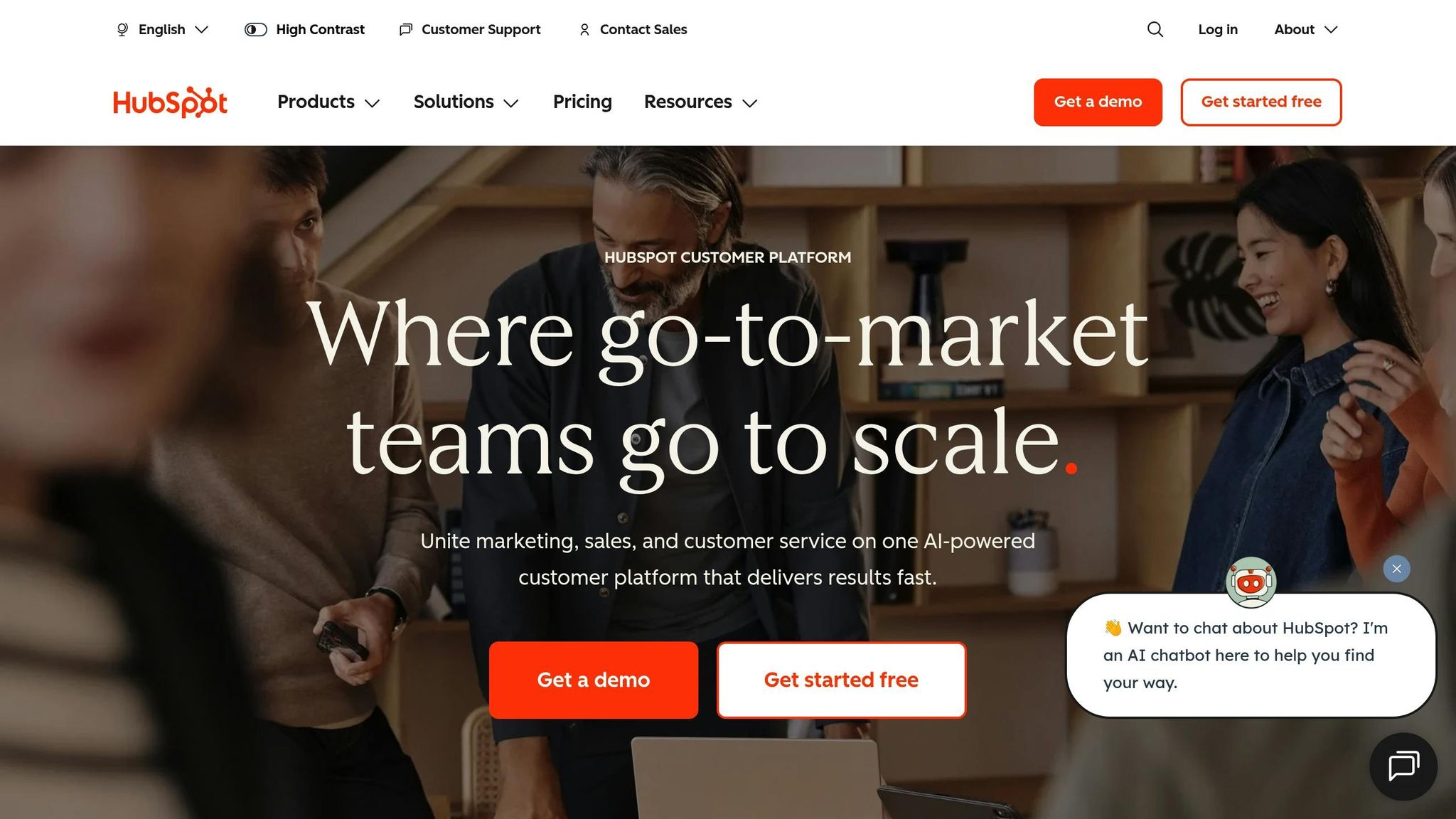Social media in 2025 is reshaping how people and brands connect. With 5.4 billion global users and 80–85% of Americans active online, platforms are now the top way for 58% of consumers to discover new businesses. People spend an average of 2 hours and 9 minutes daily on social media, engaging with brands, trends, and cultural moments like never before.
Key highlights:
- Short-form videos dominate, with 78% preferring them for product discovery.
- AI tools are speeding up content creation and personalization, but balance is needed to avoid generic content.
- Social listening is helping brands predict trends and connect with users in real-time.
- Platform trends: TikTok leads in product discovery, Instagram faces falling engagement, and Facebook thrives in niche communities.
Businesses must focus on personalized, interactive content and leverage AI tools while staying human in their messaging. The key to success lies in understanding platform-specific behaviors and using data to inform decisions.
Social Media User Statistics in the United States
Social Media Adoption and Growth Rates
As of 2025, roughly 80–85% of the U.S. population actively uses social media platforms. This positions the country among the most connected globally, with 94% of internet users engaging on social media. While adoption rates have more than doubled since 2015, annual growth has slowed to low single digits. This plateau reflects a saturated market where most Americans who want to be online already are.
Social media use has evolved beyond just logging in. On average, American users interact with seven different platforms each month, dedicating about 2 hours and 9 minutes daily to these platforms. This is slightly below the global average of 2 hours and 21 minutes. The shift suggests that users are becoming more selective with their time, possibly due to content fatigue or changing digital habits. These trends provide a foundation for exploring user demographics across various platforms.
User Demographics
Younger generations, particularly Gen Z and Millennials, dominate the social media landscape. Globally, the 18–34 age group makes up over 70% of active users, and this trend holds true in the U.S. as well. Platforms like TikTok, Instagram, and YouTube thrive on the engagement driven by these younger audiences, while Facebook and LinkedIn tend to appeal more to older users.
Gender preferences also vary across platforms. Pinterest and Instagram see higher participation from female users, while Reddit and X (formerly Twitter) attract a larger share of male users.
Geography plays a role in social media adoption. Urban and suburban regions lead the way, thanks to better internet access and higher digital literacy. Rural areas, while catching up, still show slightly lower adoption rates. Coastal and metropolitan areas, in particular, stand out for higher engagement levels and early adoption of new platform features.
| Platform Category | Primary U.S. Demographics | Engagement Characteristics |
|---|---|---|
| Short-form Video (TikTok) | Gen Z, Millennials | High daily engagement; brand interaction rates above 50% |
| Visual Platforms (Instagram) | Millennials, Gen Z | Declining engagement; carousel posts outperform Reels |
| Professional Networks (LinkedIn) | Working professionals 25–54 | Increasing engagement for professional content |
| Traditional Social (Facebook) | Broad demographics, older users | Stable engagement in niche markets |
These demographic patterns are reshaping how businesses approach social media strategies. With 48% of consumers reporting more frequent interactions with brands compared to six months ago, understanding platform-specific behaviors is crucial. Companies aiming to navigate this complex landscape effectively can benefit from expert guidance, such as the services available through the Top Consulting Firms Directory, which specializes in digital transformation and targeted social media strategies.
6 Social Media Trends Dominating 2025: What's Working NOW (Based on HubSpot's Latest Data)

New Trends in Social Media Engagement
By 2025, social media engagement is all about creating meaningful, personalized, and interactive experiences. Users are no longer just scrolling - they want content that resonates and invites them to participate across different platforms.
Interactive Content Growth
Interactive content - like short videos, polls, quizzes, live Q&A sessions, and augmented reality (AR) experiences - has risen to the top, outperforming traditional posts by encouraging active audience involvement. A striking 78% of people now prefer learning about new products through short videos, making this format a go-to for brands looking to educate and connect with their audience.
AR filters are another game-changer. Beauty brands, for instance, use AR to let users virtually try on makeup, blending fun with a hands-on way to explore products.
Three emotions - humor, curiosity, and empathy - are proving to be the secret sauce for interactive engagement. Take fitness brands, for example: they’re driving conversations with curiosity-sparking posts like, “What’s the one exercise you should never skip?” These kinds of prompts not only encourage interaction but also get users to share their own experiences.
The bottom line? Content that invites participation consistently outshines static posts, both in reach and the amount of time users spend engaging. This shift is pushing brands to rethink their strategies, with AI now playing a pivotal role in reshaping how content is created.
Generative AI in Social Media
By 2025, 69% of marketers are leveraging AI to make content creation faster, more personalized, and scalable. Interestingly, some of the highest adoption rates are in heavily regulated industries like finance and healthcare. Despite the challenges of compliance, these sectors are using AI to maintain consistent messaging while adhering to strict standards.
AI’s impact is hard to ignore: faster production times, higher post volumes, and better personalization through data-driven insights. Brands can now churn out 48–72 posts per week across platforms without overloading their creative teams.
But here’s the catch - too much automation can backfire. Over-relying on AI risks creating bland or off-key content if it’s not carefully managed. The most successful brands are striking a balance: using AI for routine tasks while leaving strategic decisions and creative storytelling to humans.
AI also allows brands to personalize content at scale and react to trends almost instantly. This is especially crucial in the fast-paced world of social media, where trends can appear and disappear within hours. Paired with advanced social listening tools, AI is helping brands stay ahead of the curve.
Social Listening Focus
Social listening tools have evolved beyond just tracking mentions - they now help brands decode audience sentiment and energy. This shift from reactive to proactive engagement has boosted interaction rates by 1.6x. Instead of waiting for customers to speak up, brands are using these tools to identify opportunities for meaningful conversations before problems arise.
One effective tactic? Engaging directly in creators’ comment sections to connect with new audiences and refine strategies based on immediate feedback. This authentic, real-time interaction often leads to higher engagement rates.
The focus isn’t just on what people are saying, but also on how they feel. These deeper insights allow brands to tweak their messaging, jump on micro-viral moments, and join conversations in a way that feels natural rather than forced.
By using social listening to identify and join trending conversations, brands are boosting visibility and connecting with younger audiences who value spontaneity and authenticity over polished corporate speak.
Companies that fully embrace social listening report benefits like smoother crisis management, happier customers, and stronger loyalty. The key is to use these insights to shape content strategies proactively, rather than just reacting after the fact. For businesses aiming to implement these advanced techniques, working with digital transformation experts - like those listed in the Top Consulting Firms Directory - can provide the tools and expertise needed to succeed in this fast-moving digital world.
sbb-itb-97f6a47
Platform-Specific Engagement Data
In 2025, each social media platform comes with its own set of challenges and opportunities, making it essential for businesses to tailor their strategies to fit the unique dynamics of each. Understanding these trends can help businesses get the most out of their social media efforts.
Facebook: Strong in Niche Communities
Facebook continues to thrive by focusing on specialized communities rather than trying to appeal to everyone. Its advanced audience segmentation tools make it a go-to platform for businesses targeting specific markets, especially older demographics who remain loyal users. For example, social media ads on Facebook are still the top source of brand awareness for internet users aged 16 to 34.
The Food & Beverage industry is a great example of how niche markets succeed on Facebook. From craft beer fans to vegan cooking groups, businesses are using Facebook’s community-building features and precise targeting to engage directly with these audiences. On average, marketers spend $46.47 per user to connect with social audiences on the platform. This focus on niche targeting reflects a broader shift toward precision marketing across social platforms in 2025.
While Facebook thrives in its niche, Instagram is facing a different set of challenges.
Instagram: Adapting to Falling Engagement
Instagram has seen a sharp decline in engagement over the past year. The median engagement rate plummeted from 2.94% in January 2024 to just 0.61% in January 2025, a drop of about 79%. This decline is forcing influencers and brands to rethink how they use the platform.
Despite the drop in public engagement, Instagram’s private messaging has grown by 23% since Q4 2021. This shift shows that while public interactions are waning, private and direct communication remains strong. Many influencers are leaning into authenticity, moving away from overly polished content. Instead, brands are experimenting with more casual, unfiltered posts, using this period of change to test new styles and tones. This shift aligns with what some call "vibe culture", where brands focus on creating emotional connections rather than chasing viral moments. Social listening tools and AI help decode trends, allowing brands to craft longer-lasting connections.
Given that the average person now uses 6.83 different social networks each month, influencers are also diversifying their presence across platforms to avoid over-reliance on Instagram’s fluctuating engagement.
Meanwhile, TikTok and X are showcasing entirely different dynamics, offering both challenges and opportunities.
TikTok and X: Evolving Strategies for Engagement
TikTok and X highlight the growing importance of adapting to each platform’s culture. TikTok, for instance, has become a favorite for learning about new products, with 78% of users preferring short video content for product discovery. However, its rapid content consumption means brands must constantly innovate to keep up. TikTok’s messaging feature has also grown significantly, with a 58% increase in usage since Q4 2021, showing that the platform is evolving beyond its short-form video origins.
TikTok’s algorithm rewards creative, authentic content over polished productions, offering brands a chance to connect with younger audiences in a more relatable way. Its ads deliver a return on ad spend (ROAS) of 2.4x compared to traditional display ads, making it a valuable option for businesses targeting younger demographics who increasingly favor social media over traditional media.
On the other hand, X (formerly Twitter) has become a playground for creative experimentation. Brands are testing new tones, humor, and authenticity, often because the platform lacks rigid guidelines for traditional branding. This allows social teams to push boundaries, creating unfiltered, real-time content that resonates with audiences. X’s fast-paced environment rewards brands that quickly engage with trending topics while maintaining an authentic voice. It’s less about polished campaigns and more about being part of the conversation.
Both TikTok and X emphasize a key trend in 2025: social media success depends on treating these platforms as spaces for genuine interaction rather than just advertising. Brands that understand and adapt to each platform’s culture are the ones finding the most success.
Business Applications
The evolving social media landscape of 2025 pushes businesses to turn insights into action. Success now hinges on a smart combination of AI-driven tools and human expertise. To stay ahead, companies must embrace data-driven strategies while knowing when to bring in experts to guide their digital transformation efforts.
Using AI and Data Analytics
AI has become a cornerstone of social media success. Take Meta's AI-powered Advantage+ Placements, for example - these deliver a 4% higher click-through rate and a 3.8% boost in conversions compared to standard placements. Businesses are leveraging AI for tasks like content creation, audience targeting, and campaign optimization. Generative AI now crafts personalized content designed to resonate with specific audiences, while AI-powered analytics dig deep into user behavior, enabling businesses to fine-tune campaigns with impressive precision.
Data analytics is equally critical for optimizing campaigns. With global social ad spending projected to exceed $276.72 billion by 2025, businesses need to make every dollar count. Tools that track engagement metrics and spot emerging trends allow for real-time adjustments to content strategies. Native visual ad formats, for instance, consistently outperform traditional ads, particularly in today’s mobile-first world. By 2030, 83% of social ad budgets are expected to target mobile platforms, with U.S. users already spending an average of 2 hours and 9 minutes daily on social media. AI tools that adapt targeting and creative elements on the fly are becoming essential for success.
These advancements are setting the stage for a shift where businesses not only adopt cutting-edge tools but also integrate them seamlessly into broader marketing strategies. This is where expert guidance becomes invaluable.
Working with Expert Consulting Firms
Even with advanced AI and analytics, businesses often need specialized consulting to fully realize their digital transformation goals. Consulting firms bring expertise in aligning social media strategies with overarching business objectives, such as boosting revenue or enhancing brand visibility.
The Top Consulting Firms Directory (https://allconsultingfirms.com) offers a resource for businesses seeking firms that specialize in areas like digital transformation and strategic management. These consultants help balance AI-driven content with a human touch, streamline platform integration, and address technical challenges.
Consultants also excel in measuring and optimizing ROI. They track critical metrics like cost per click (CPC), cost per thousand impressions (CPM), and return on ad spend (ROAS). For instance, TikTok ads achieve an average ROAS of 2.4× compared to traditional display ads, helping businesses allocate their budgets to the most effective platforms and formats.
Integrating AI and analytics into existing teams requires more than just tools - it demands structured change management. Expert consultants provide training, define clear roles, and establish workflows that help teams embrace data-driven strategies without losing the creative edge audiences expect. With 93% of marketers planning to increase their focus on social media by 2025, combining advanced technology with expert guidance is key to building campaigns that are both authentic and high-performing.
Conclusion: Preparing for Future Social Media Engagement
The social media landscape in 2025 is shifting rapidly, bringing both challenges and opportunities that demand swift action. Engagement rates are dropping across major platforms - X down 48%, Facebook 36%, TikTok 34%, and Instagram 16% - making it clear that outdated strategies no longer cut it. These numbers highlight the urgent need for businesses to rethink how they create and share content.
The data reveals some important trends. Low-production, authentic videos are outperforming polished, highly produced content, and carousels have outpaced Reels in engagement on Instagram. These aren't just passing fads; they reflect a deeper shift in how users engage with brands online. Ignoring these changes could mean losing out on valuable customer connections.
To succeed, businesses must act fast, delivering content that resonates with increasingly distracted audiences. With 65.7% of the global population actively using social media, competition for attention is fiercer than ever. Some sectors, like Higher Education and Nonprofits, have already found success by focusing on content that feels personal and purpose-driven, such as campus updates or cause-related campaigns.
Winning in this environment requires a two-pronged strategy: embracing advanced technology while staying grounded in human insight. AI-powered tools can provide powerful analytics, but their true potential is unlocked when paired with strategic expertise. The brands thriving in 2025 are those that quickly adapt to emerging trends, using data to inform decisions while fostering authentic community connections. For businesses seeking guidance, resources like the Top Consulting Firms Directory (https://allconsultingfirms.com) offer access to experts in digital transformation and social media strategy, ensuring they don’t face these challenges alone.
The key takeaway? Social media engagement is no longer just about posting content - it's about building real, meaningful relationships in an increasingly noisy digital world. By understanding these trends now and leveraging the right mix of tools and human insight, businesses can position themselves to capture attention and achieve lasting success in this evolving landscape.
FAQs
How can businesses use AI for content creation while maintaining a personal, human touch?
To strike the right balance between AI and human creativity in content creation, businesses should view AI as a tool to support, not replace, the creative process. AI can take care of time-consuming tasks like drafting outlines or analyzing data trends, freeing up humans to focus on the elements machines simply can't replicate - storytelling, emotional depth, and building personal connections.
When businesses combine the efficiency of AI with the unique creativity of humans, the result can be content that feels both engaging and genuine. It’s also crucial to routinely review AI-generated material to ensure it reflects your brand’s voice and values, helping to maintain a meaningful connection with your audience.
How can brands keep their audience engaged on Instagram despite declining public interaction?
To keep Instagram engagement alive as public interactions dwindle, brands need to pivot toward building genuine connections with their audience. This means crafting content that feels real and relatable, using interactive tools like polls, Q&A sessions, and stories to spark conversations, and actively encouraging responses through comments and direct messages.
It’s also crucial to dive into engagement metrics to figure out what clicks with your audience. Adjusting your approach based on this data can make all the difference. Partnering with influencers or launching targeted campaigns can further amplify reach and interaction. At the heart of it all, standing out in the crowded digital landscape boils down to being consistent, inventive, and authentic in your communication.
How can companies use social listening tools to better connect with their audience and build brand loyalty?
Companies have a powerful ally in social listening tools, which help them track online conversations about their brand, industry, and competitors. By diving into this data, businesses can spot emerging trends, respond quickly to customer feedback, and fine-tune their content to align with what their audience wants.
Using insights from social listening, brands can actively engage with their customers - addressing concerns, celebrating positive feedback, and building a deeper emotional connection. This kind of interaction doesn’t just boost customer satisfaction; it shows customers that their opinions matter, strengthening loyalty and creating lasting relationships.


